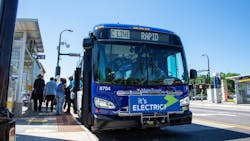Met Council approves expansion of Minneapolis' Metro Transit's electric bus fleet
The Minneapolis area’s Metro Transit will be expanding its electric bus fleet following the approval of two contracts with bus manufacturer GILLIG with the help of the Metropolitan Council (Met Council).
The 20 new 40-foot buses will be used on local routes determined to be the best fit based on Metro Transit’s Zero-Emission Bus Transition Plan. The plan calls for a phased introduction of buses powered by batteries or other alternatives to diesel fuel.
Metro Transit put its first eight electric buses into service in 2019 and will put five more into service on the Metro Gold Line in 2025.
The GILLIG buses that will be purchased through the contracts approved will be the agency’s first 40-foot electric buses and are expected to enter service in 2026.
“The Met Council and Metro Transit are working hard to reduce our carbon footprint,” said Metro Transit General Manager Lesley Kandaras. “Expanding the electric bus fleet is one step we are taking towards the cleaner, healthier environment we envision for our region.”
In total, the Met Council is investing more than $34 million in electric buses and charging equipment through the new contracts. The investment is supported by a combined $21.6 million in Federal Transit Administration grants.
Funding will also support efforts to continue an apprentice program for technicians and to provide staff ongoing training on electric bus technologies.
The investment supports and advances Met Council’s Climate Action Work Plan, which builds on the organization’s track record of climate change planning, emissions reductions and more resilient outcomes. The plan unifies efforts across Met Council divisions and aligns with Minnesota’s Climate Action Framework.
“We take the work of our Climate Action Work Plan very seriously,” said Lisa Barajas, Met Council's executive director of community development and sponsor of the council-wide climate action work. “Given our planning responsibilities and as one of the state’s largest energy users and owners of the largest public vehicle fleet, we have significant opportunities to reduce emissions and improve resiliency in our operations and facilities.”
